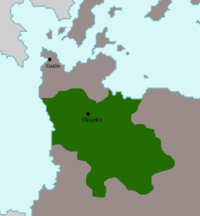Térachu state
Térachu State Itataki P'utusko | |
|---|---|
| 1182–1603 | |
|
Reconstruction of the Tsatsa's motif | |
 The Térachu state state in green, with the modern borders of Satucin in dark grey | |
| Capital | Tikujek'e |
| Official languages | Marai |
| Common languages | Gean, Namba |
| Religion | Marai religion, Solarian Catholicism (after 1527) |
| Government | Monarchy |
| Tsatsa | |
• 1182-1214 | Nindanimbe |
• 1315-1346 | Nitsak'ani |
• 1510-1523 | Kunomik'ï |
• 1597-1603 | Tsiasa |
| Resident | |
• 1551-1557, 1561-1574 | Matheus Morin |
| History | |
• Foundation of Tikujek'e | 1182 |
• Conversion of the Tsatsa to Sotirianity | 1522 |
• Gaullican suzerainty established | 1527 |
• Annexation by Gaullica | 1603 |
| Population | |
• 1500 | 2,000,000 |
• 1560 | 600,000 |
• 1610 | 500,000 |
| Today part of | |
The Térachu State, known internally as Itataki P'utusko (literally meaning Elder Uncle State), and also called Ticujec by early Gaullican settlers, was a polity in pre-Avenard Satucin. A major power in Medasteria, it comprised a large part of the modern state of Anniane, and was the second-largest state in pre-Assim Asteria Inferior, after Cutinsua.
It was founded in the late 12th century by the Térachu, a Marai tribe who had migrated into the interior. The Térachu founded the city of Tikujek'e, which would later become the capital, and subjugated neighbouring cities. Although it started out as a relatively decentralised tributary system revolving around Tikujek'e, within a century it became highly centralised. While often compared to its contemporaries, Cutinsua, Tzapotlan, Calkhun, Itzel, and !Muisca, it diverged in a key way. Its contemporaries usually defined themselves through a network of urban centres revolving around a metropolis, while the Térachu maintained a marked and fortified border, potentially constituting the first and perhaps only territorial state in the Asterias.[1][2]
The urban polities of the coastal Marai had largely relied on extensive trade links throughout the Asterias to maintain their urbanisation and wealth, while the Térachu quickly gained access to the mineral wealth of the interior. Gold and salt mines formed the basis of the economy, while an abundance of copper and silver allowed metallurgy to flourish. Items found in both Cutinsua and Térachu indicate a large-scale trade system flourished between the two polities.
The Gaullican arrival in 1517 did not go unnoticed, and in 1520 Rasse Féret and several other explorers were invited to Tikujek'e where they met with the Tsatsa (king) Kunomik'ï. The meeting was positive, and resulted in a second embassy in 1522. During that meeting Kunomik'ï converted to Sotirianity, taking the name Francois, after the Gaullican monarch at the time Francois I, and symbolically offered his chain of office to a portrait of Francois I. Féret mistook this gesture as Kunomik'ï becoming a Gaullican vassal, and not a ceremonial acknowledgement of Francois' status as an equal. Matheus Morin was left behind to serve as Gaullica's envoy. Kunomik'ï became concerned by the behaviour of the Gaullicans, especially Morin who treated the Tsatsa as a subordinate. The installation of a garrison in 1525 caused an outbreak of hostility, but Kunomik'ï's death led to Kuokisiska's ascension to the throne and peace between the two sides.
Kuokisiska soon grew hostile to the Gaullicans when they began to show no signs of intending to leave, and became openly hostile when he learned they had been entreating with his governors and enemies behind his back. His attempt to expel them from the city failed after a joint Gaullican and native relief force arrived. Kuokisiska fled to the Carajé Confederation for aid, though the Carajé murdered him for the substantial Gaullican bounty. His cousin, Mokumitsa, was placed on the throne. Féret defeated several rebellions and consolidated Gaullican control of the state, forcing Mokumitsa to formally accept Gaullican sovereignty.
From 1527 to 1603 the Térachu state existed as a vassal to Gaullica. It remains notable as the only indigenous polity to actually expand after contact with Eucleans. During this period its institutions largely remained intact, although disease took a heavy toll and many of its urban centres declined and some were abandoned. The Tsatsa largely became a figurehead while Gaullican Residents managed affairs. The nobility became divided between Gallophiles (tsigalika) and the anti-Gaullican (motsatsa) which sometimes escalated into armed conflicts. During the late 16th century Banniérants began moving into the interior in search of gold and started illegally annexing Térachuan land. The Gaullican Residents turned a blind eye which provoked a large-scale revolt in 1599. The reigning Tsatsa, Tsiasa, sided with the Gaullicans and was forced to flee Tikujek'e for Aneville. The revolt was soon crushed and in 1603 the state was officially annexed into the colony of Anniane.
The Tsatsa and the royal family, the "Uk'uï" (Alligators), were integrated into the Gaullican nobility as the de Térache family who reside in Gaullica, Satucin, and Garambura to this day.
Name
History
Pre-Avenard
First contact
Gaullican suzerainty
Revolt and annexation
Geography
Culture and society
Religion
Notes
- ↑ This is a common point of dispute between historians, particularly those of Cutinsua who argue that it also constituted a territorial state
- ↑ Gage, Gustave (2014). "The Territorial State of Asteria Inferior: Térachu and the Frontier". Imperial Academy: 16. Retrieved 2018-06-09.
By establishing border fortifications, and representations of their state based on its frontiers and not urban centres, the Térachu had created the first and only territorial state in the Asterias
Cite journal requires|journal=(help)
